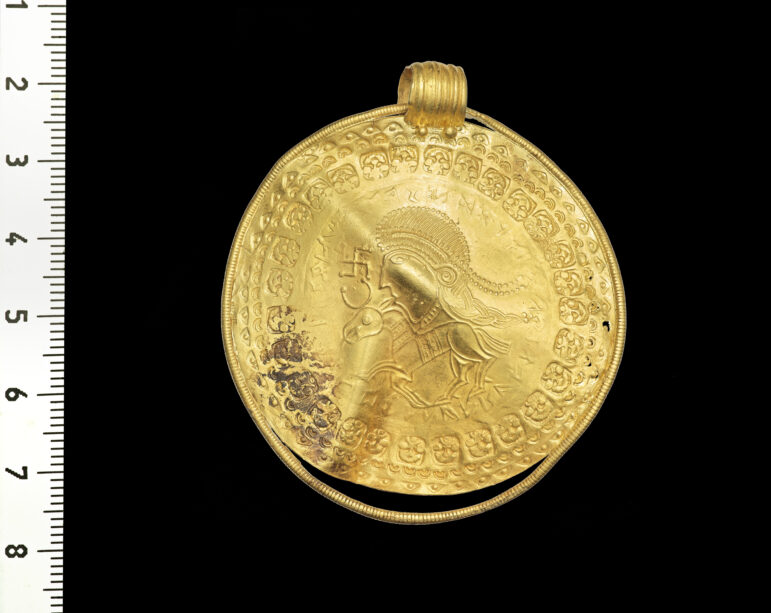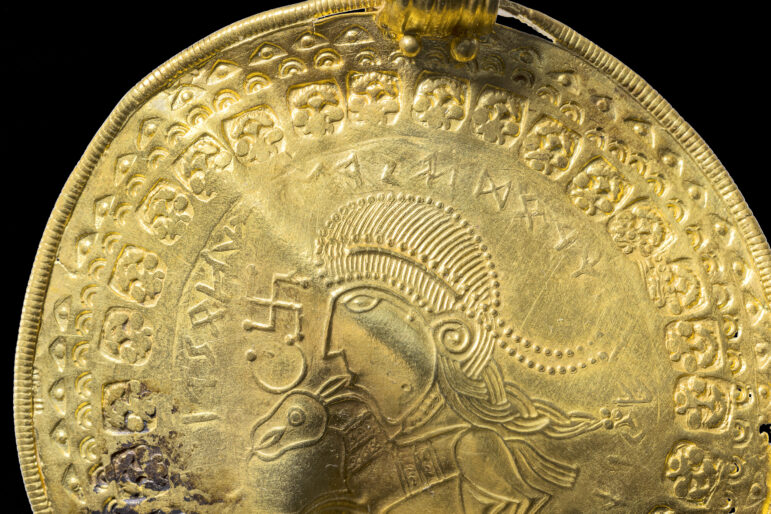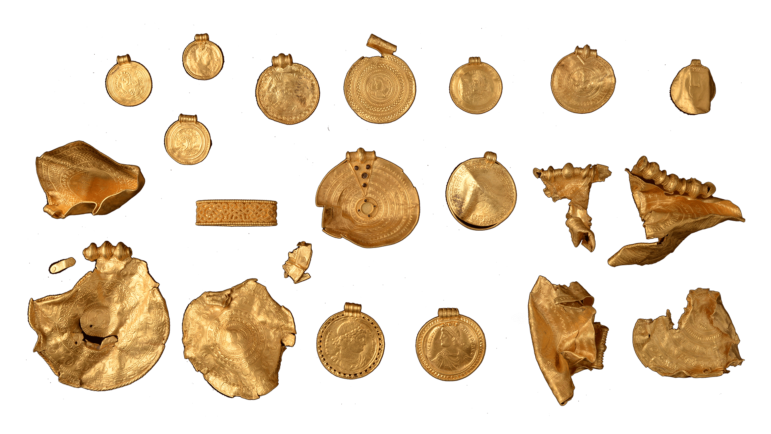COPENHAGEN, Denmark – Last month, archeologists from the National Museum in Copenhagen announced that they have found the earliest known inscription that mentions the Norse god Odin. The inscription dates to the early 5th century, over 150 years earlier than a 6th-century brooch from southern Germany that was the previous earliest mention of the god.
The inscription is found on a gold bracteate that was found in the Vindelev Hoard, the “dream find” that The Wild Hunt reported on in October 2021. The inscription reads “iʀ Wōd[i]nas weraʀ,” which has been translated as “He is Odin’s man.” Krister Vasshus, a linguist who worked on the project, mentions that there is also a nickname present, “JagaR,” who was likely the local ruler at the time of the bracteate’s production.

The gold bracteate with the Odin inscription. Photo: Arnold Mikkelsen, The National Museum of Denmark.
The inscription surrounds an image of a human head in profile above an animal interpreted as a horse, along with a swastika and a crescent symbol. The latter two items may represent the sun and moon.
The inscription “can tell us something about the relationship people had with their gods and possibly even how divine rulership was organized in Scandinavia at this time,” Vasshaus said to NBC News. “The carver knew exactly how to shape the runes to make them perfect, simply perfect.”
Lisbeth Imer, a runologist with the National Museum, agrees. “It’s one of the best executed runic inscriptions that I have ever seen,” she says.
Bracteates are thin golden single-sided pendants. They provide much of our archeological evidence for pre-Viking Age Germanic religion. They were created with a bronze matrix which was then stamped into a gold plate to create the amulet. Frequently they seem to depict rulers or mythological figures, along with animals like horses or birds. There are more than 1,000 Northern European bracteates on record, with more than 200 bearing runic inscriptions.
Researchers from the National Museum have conducted excavations in the area where the hoard was found and discovered evidence of longhouses and fences, which reinforces the idea that the hoard was buried by a local ruler.
Although the runes are excellently formed, the inscription is worn down, such that some runes are now difficult to read. The inscription begins with an uncertain word, “hostiōz,” which may be a Latin loanword that would mean “sacrificial animals.” The “He is Odin’s man” section is at the end of the inscription and is well-preserved.
“Not only has the structure of the language developed tremendously since the 5th century, but many words have also fallen out of use,” says Vasshus, but “generally, we find short runic inscriptions with fairly comprehensible content, but this time the text is long and consists almost entirely of new words. That made it extremely difficult to interpret. In itself, the interpretation is quite a major achievement, which will help us understand other runic inscriptions – on other bracteates, for instance.”

A close-up of the inscription. Photo: Arnold Mikkelsen, The National Museum of Denmark.
There is a second bracteate in the hoard that contains a similar inscription, but it is not identical: the second inscription transposes the “d” and “W” runes in Odin’s name, an apparent mistake in transcription. (The shapes of these runes, known to modern Heathens as the Elder Futhark runes we call “Thurisaz” and “Wunjo,” are very similar, especially at such a small scale.) The runes on the second bracteate are also generally not created at the same level of skill. This means the two bracteates were not formed from the same matrix, despite their similarities. But while the second bracteate may not be as impressive as the first, the fact that there are multiple renditions of the bracteate with the same inscription suggests that it is a formula that would have appeared on even more pendants.
And indeed, a third bracteate has been found – in the National Museum’s own collection. There is a bracteate found in 1852 in Bolbro that has been in the National Museum ever since that is made from an identical matrix as the second, less impressive bracteate from the Vindelev hoard. However, it could not be identified as an Odinic inscription until now, due to the rune-carver’s mistake.

Items from the gold hoard [Vejlemuseerne]
Odin is well-known to modern Heathenry and Paganism as the ruler of the Norse gods called the Aesir. He is identified as a god of magic, poetry, war, and kingship. Most of our information about Odin comes from medieval literary sources like the Icelandic Eddas, Saxo Grammaticus’s Gesta Danorum, and Old English poetry like the “Nine Herbs Charm,” all of which were written down many centuries after this inscription after most in Scandinavia had converted to Christianity.
“The runic inscription was the most difficult I have ever had to interpret in all my years as a runologist at the National Museum of Denmark,” says Imer. “But the discovery is also absolutely amazing. It is the first time in the history of the world that Odin’s name was mentioned. This means that Norse mythology can now be dated all the way back to the early 5th century. This just makes the Vindelev hoard even more spectacular. Since the golden horns, I’ve never seen such well-executed runes and such a long text on a Danish find from this period. It may help us understand other prehistoric runic inscriptions, which we haven’t yet been able to read.”
The bracteate is on display at the Danish National Museum as part of its exhibition “The Hunt for Danish History,” which runs for the rest of 2023. A scholarly article with further analysis of the bracteate is forthcoming later this year. In the meantime, the documentary Gåden om Odin (“The Odin Riddle”) chronicles the scholars’ work of interpreting this bracteate.
The Wild Hunt is not responsible for links to external content.
To join a conversation on this post:
Visit our The Wild Hunt subreddit! Point your favorite browser to https://www.reddit.com/r/The_Wild_Hunt_News/, then click “JOIN”. Make sure to click the bell, too, to be notified of new articles posted to our subreddit.